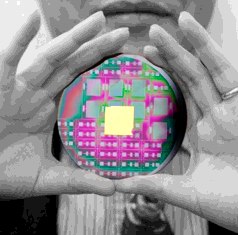Chip-scale light control coming
 Australian engineers have created a new chip for the manipulation of light on the nano scale.
Australian engineers have created a new chip for the manipulation of light on the nano scale.
The device could be big news for anything from next-gen optical technologies to enabling deeper understanding of black holes.
The integrated nanophotonic chip can achieve unparalleled levels of control over the angular momentum (AM) of light, which opens new opportunities for using AM at a chip-scale for the generation, transmission, processing and recording of information.
It could also help scientists better understand the evolution and nature of black holes.
While light travels essentially in a straight line, its beam also spins and twists around its optical axis.
The angular momentum of light, which measures the amount of that dynamic rotation, has attracted tremendous research interest in recent decades.
A key focus is the potential of using AM to expand the available capacity of optical fibres by using parallel light channels – an approach known as “multiplexing”.
But achieving AM multiplexing on a chip scale has remained a major challenge, as there is no material in nature capable of sensing twisted light.
By designing a series of elaborate nano-apertures and nano-grooves on the photonic chip, the team from RMIT University has enabled the on-chip manipulation of twisted light for the first time.
“If you send an optical data signal to a photonic chip it is critical to know where the data is going, otherwise information will be lost,” says lead author Haoran Ren, a PhD candidate at Swinburne University of Technology.
“Our specially-designed nanophotonic chip can precisely guide AM data signals so they are transmitted from different mode-sorting nano-ring slits without losing any information.”
As well as laying the foundation for the future ultra-broadband big data industry and providing a new platform for the next industry revolution, the research offers a precise new method for improving scientific knowledge of black holes.
“The design removes the need for any other bulky interference-based optics to detect the AM signals,” RMIT’s Professor Min Gu said.
“Our discovery could open up truly compact on-chip AM applications such as ultra-high definition display, ultra-high capacity optical communication and ultra-secure optical encryption.
“It could also be extended to characterise the AM properties of gravitational waves, to help us gain more information on how black holes interact with each other in the universe.
“Due to the fact that rotating black holes can impart OAM associated with gravitational waves, an unambiguous measuring of the OAM through the sky could lead to a more profound understanding of the evolution and nature of black holes in the universe,” he said.
Their work has been accepted for publication in an upcoming edition of the journal Science.








 Print
Print